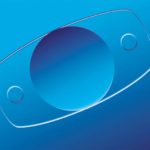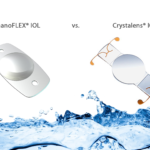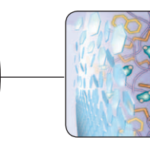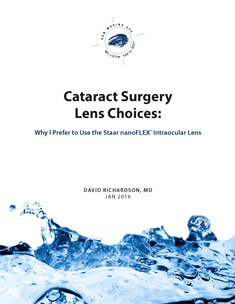
Downsides to the Multifocal IOL
A multifocal intraocular lens (IOL) focuses both distance and near images onto the retina at the same time. Amazingly, our retinas and brains are generally able to “see” both images clearly. This results in a greater range of clear vision with a reduced need for spectacles after cataract surgery. There are, however, some downsides to the multifocal IOL:
Decreased Contrast Sensitivity
Every edge, shadow, and non-moving object depends on our ability to detect contrast for it to be seen. Unfortunately, multifocal intraocular lenses (IOLs) decrease our sensitivity to contrast. This is seldom an issue during the day when strong illumination from the sun tends to create a high contrast environment. However, during dawn, dusk, or night the ability to distinguish between low-contrast objects becomes critical (think of a grey hooded child at the edge of a road). Some hobbies such as hunting also rely on the ability to detect objects that blend into (have very low contrast with) their environment.
Halos Around Lights
After cataract surgery with a multifocal intraocular lens (IOL), two images of everything in one’s visual field are focused onto the retina: both clear and blurred near images as well as clear and blurred distance images. The retina and brain are pretty good at distinguishing which image should be ignored. There is one main exception: point sources of light. With multifocal IOLs, headlights, traffic lights, dashboard indicators, etc. will all have noticeable halos around them at night. Many people do get used to these a few months after cataract surgery, but they never entirely disappear.
My practice is located in greater Los Angeles which has woefully inadequate public transportation. As such, almost all of my patients need to drive at night and would find night-time halos around oncoming headlights unacceptable.
Not Everyone Can Tolerate the Multifocal Images
Many people are able to adapt to the halos and “ghosting” of images that are present after cataract surgery with use of a multifocal intraocular lens (IOL). This process of getting used to the unusual dual images created by a multifocal IOL is called “neuro-adaptation”. Frankly, we have no idea how the retina and brain adapt to these dual images. What is amazing is that most people are able to tolerate having a focused and blurred image of everything simultaneously projected onto their retinas.
“Most people”…but not everyone.
Unfortunately, there is no test that can be performed prior to cataract surgery that can accurately predict who is likely to tolerate the dual images generated by multifocal IOLs. If neuro-adaptation does not kick in within a few months of cataract surgery then the multifocal IOL may have to be surgically removed and replaced by a monofocal or pseudo-accommodating IOL.
Multifocal IOLs Are Not a Good Choice for Most People Considering Cataract Surgery
When multifocal intraocular lenses (IOLs) work they really can provide an outstanding range of daytime vision. Additionally, not everyone needs to drive at night or is bothered by rings around point sources of light after cataract surgery with a multifocal IOL. Even so, a large percentage of people with cataracts simply are not good candidates for placement of a multifocal IOL at the time of cataract surgery due to the presence of other eye disease. Following is a short list of eye conditions that would limit the benefit of a multifocal IOL:
Eye Conditions That Would Limit the Benefit of a Multifocal IOL
Ocular Surface Disease (Dry Eye Syndrome)
In order for a multifocal IOL to work well the cornea must be smooth and without astigmatism. Ocular Surface Disease (of which Dry Eye Syndrome is the most common) results in an irregular tear film on the corneal surface. Without a healthy tear film the cornea cannot finely focus light onto the lens. My practice is located in Southern California which is an arid (dry) environment. This results in evaporative tear loss. As such, almost all of my patients have at least some evidence of ocular surface disease and may not be appropriate candidates for the multifocal IOL.
Glaucoma
Many people think of glaucoma as a disease that limits peripheral vision. In the latter stages, however, glaucoma can impact central vision. Even with only moderate glaucoma contrast sensitivity can be decreased. Multifocal IOLs also reduce contrast sensitivity (see above). As such, implanting a multifocal IOL during cataract surgery in a glaucoma patient is potentially unwise.
Macular Disease
In order for a multifocal IOL to provide both distance and near vision the central retina (“macula”) must be in excellent condition. Any eye disease that limits central vision will degrade the range of vision possible with a multifocal IOL. Most everyone with significant macular disease should avoid implantation of a multifocal IOL at the time of cataract surgery.
Diabetic Eye Disease
Diabetes can limit central vision due to swelling in the macula. In the earliest stages this might not even be noted with the natural lens or monofocal intraocular lens (IOL). However, even mild amounts of macular swelling can severely limit the quality of vision when a multifocal IOL is placed during cataract surgery. Those with diabetes (especially if uncontrolled or with known retinopathy) should generally avoid placement of a multifocal IOL during cataract surgery.
Dry eye, glaucoma, macular degeneration, and diabetic eye disease all have one thing in common with cataracts: they are more likely to occur as we age. As such, most anyone considering cataract surgery is at risk of either already having or eventually developing one or more of these conditions. My personal philosophy is that I would like the lens implanted at the time of cataract surgery to work well for the life of the individual having cataract surgery. As most eye diseases get worse as we age, I generally recommend against the use of multifocal IOLs in my patients who already have other significant eye diseases.
Fortunately, the Staar nanoFLEX® IOL does not share any of the above concerns. Its use is not limited by the presence of other eye diseases, halos are rarely seen, and it provides for excellent contrast sensitivity.









Recent Comments